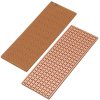Hi all,
I'm a newby here and only have a fairly basic electronics knowledge.
What I am wanting to know is how to convert a variable resister to a variable voltage output, very low current draw as it just runs an electronic fuel gauge.
The output of the sender varies from 10 ohms (empty) to 149 ohms (full).
The input to the gauge needs to be 0.1v empty and 4.5v full.
Supply voltage is a regulated 12VDC.
I played around with a resistor calculator but couldn't find that happy medium.
Can any one help me with this? Can this be done simply or will it require something a little more elaborate??
Thanks in advance!
Matt
I'm a newby here and only have a fairly basic electronics knowledge.
What I am wanting to know is how to convert a variable resister to a variable voltage output, very low current draw as it just runs an electronic fuel gauge.
The output of the sender varies from 10 ohms (empty) to 149 ohms (full).
The input to the gauge needs to be 0.1v empty and 4.5v full.
Supply voltage is a regulated 12VDC.
I played around with a resistor calculator but couldn't find that happy medium.
Can any one help me with this? Can this be done simply or will it require something a little more elaborate??
Thanks in advance!
Matt








